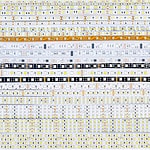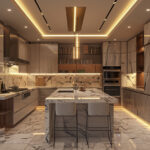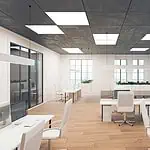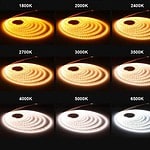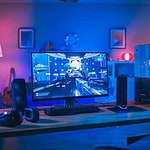The food’s color and other ingredients appear different for varying light colors, which can mess up your cooking. For this reason, choosing the right light color for the kitchen is essential to ensure a comfortable cooking or food preparation experience.
Before selecting the light color for your kitchen, you must consider the size and color of the cabinets & walls. For instance, warm lights look best on wooden kitchen cabinets; again, cool lights are preferable for black cabinets. Nevertheless, bright white lighting is best for working on a kitchen station. Yet, if you want a cozy vibe in the kitchen, yellowish-warm lights are also an excellent option to go. However, the point to note is that warm lighting can make your kitchen look smaller.
No worries, I will describe here how to choose the right color, its importance, different types of colors, and many more. So, no more talking; let’s dive into the main section–
Importance Of Choosing The Right Color Lighting For Kitchen
There is no alternative to selecting the correct color lights for your kitchen. So, ensure proper visibility and create an inviting environment to work in the kitchen. You can do tasks like chopping, cooking, and cleaning efficiently with suitable illumination.
However, if the lighting is too dim, it can lead to safety hazards. Also, with less visibility, you aren’t able to handle sharp objects or hot stoves. On the other hand, when the light is too bright, it will create discomfort and glare. Therefore, you need to choose wisely a perfect color for your kitchen space to avoid these incidents.
Light Color For A Kitchen
There are different light colors available for other kitchen spaces. Let’s see some of the most common kitchen lighting here–
Warm light (2700K-3000K)
Warm lights with color temperatures between 2700K and 3000K create a cozy and inviting ambiance in the kitchen. If you want to keep the atmosphere of the kitchen comfortable and playful, warm lights are a great option to go for. These warm lights work excellently for undercabinet lighting in the kitchen. You can either go LED strips or puck lights of yellowish tone. To learn more, check this- Under Cabinet Lighting Guide.
Natural Light (3500K-4000K)
A natural color temperature light can make your kitchen area airy and bright ideally. Also, this lighting can provide a balance and neutral illumination over the whole space. The natural lights are ideal for cooking and preparing food. So, with this type of light, you can enhance visibility and quickly assess the true colors of ingredients and food. Besides, this light color is also suitable for modern kitchen design with a focus on functionality.
Cool Light (4000K – 5000K)
With the cool lighting, you can give your kitchen a modern and clean look. And the bluish-white light is a practical choice as it can increase the focus of your cooking spaces. In addition, this temperature can reduce eye strain and improve clarity. So, it is excellent for tasks such as chopping and meal preparation in the kitchen.
Daylight (5000K – 6000K)
High-temperature light fixtures ranging from 5000K to 6000K give a bluish daylight effect. This CCT is suitable for professional and commercial kitchens. The most significant feature of this light is it helps ingredients and dishes appear in vivid and accurate color. Besides, this light mainly goes well with a relatively small kitchen as it provides an airy and open area.
Choosing The Right Color Lighting For the Kitchen: Three Main Factors
Considering functionality, aesthetics, and versatility, you can select the right light color for your kitchen space. For instance,–
Functionality
Functionality means the illumination you need in your kitchen area for working purposes. It is not about preferences or design. It’s about how simply one can get the work done. For example, a kitchen requires sufficient light in all working spaces. That way, you can make food more effectively and safely. And nobody spends much time in the kitchen except cleaning, cooking, etc.
Hence, regarding color temperature, you should choose a higher value on the Kelvin scale, around 4000K-4500K, which is a bluish tone. Also, cooler light aids concentration and productivity, which is ideal for task-oriented lighting. Besides, this temperature is well-suited for under-cabinet lighting, above the sink, or pendant lights illuminating your kitchen island. And above all, you can get proper visuals of the food and ingredients color and cook accordingly.
Aesthetics
For aesthetic looks in your kitchen, you can choose lights such as chandeliers and recessed can lights. As these fixtures have multiple varieties, you can select one based on the design of the kitchen and your personal preferences. If your kitchen is transitional and traditional, combined with stone or wood, go for warmer lights. Conversely, Scandinavian and minimalist modern kitchens work well with relatively cooler light colors.
However, before making any hasty decisions, take a moment to think about the color temperature used in the rest of your home. It’s essential to aim for a smooth transition from other areas to the kitchen. A sudden shift in lighting can be jarring and disrupt the overall flow.
Versatility
If you want to get the best output of the kitchen lighting, consider versatility. In this case, mix-matching both cool and warm light tones is not an ideal plan to execute. The result will end up creating a mass. So, I suggest you go for a tunable light fixture that has a CCT adjustable feature. Using these fixtures in your kitchen, you can customize the light color to your comfort CCT. To learn more about these fixtures, read this- Tunable White LED Strip: The Complete Guide.
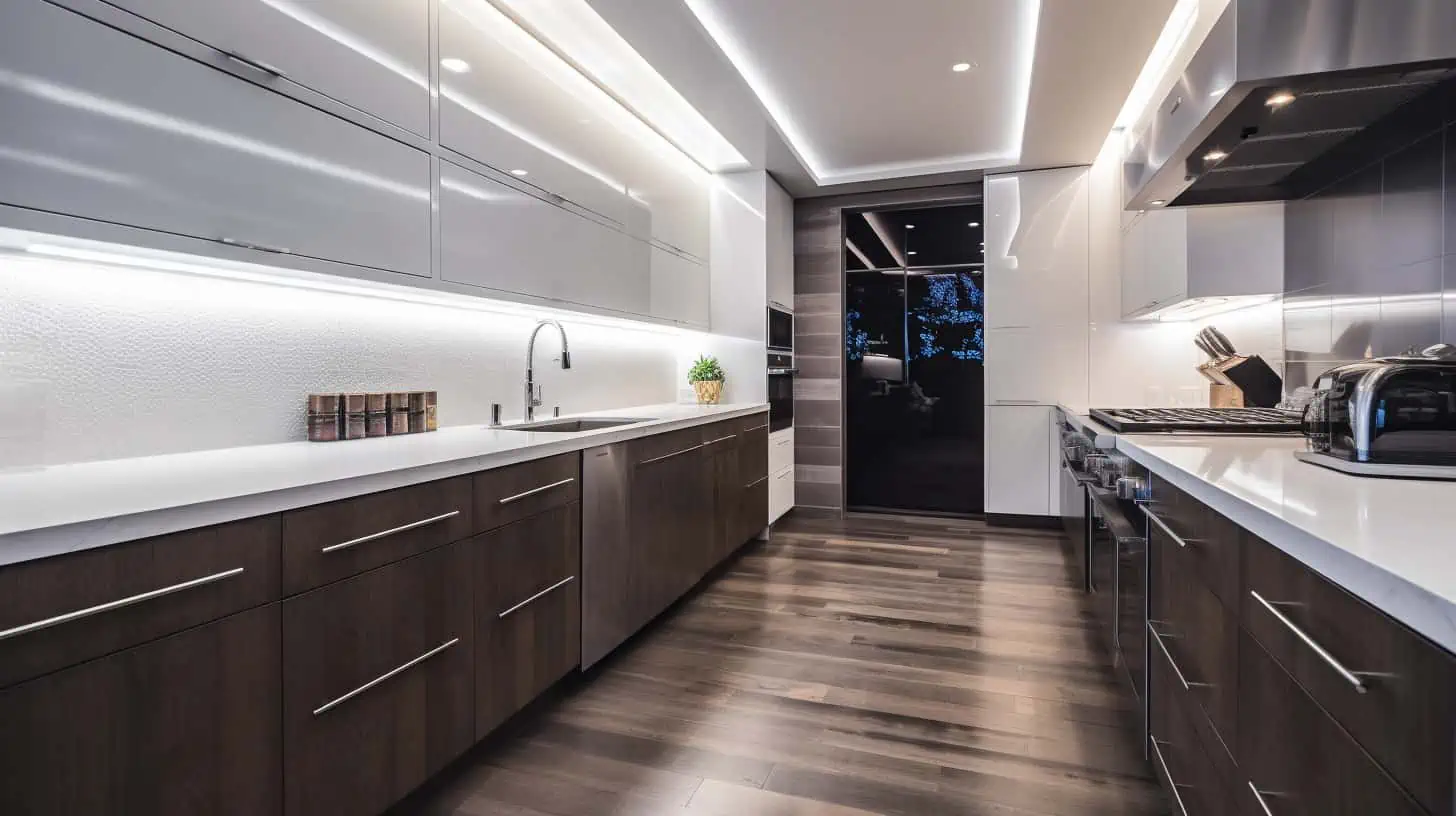
4 Layers Of Light Rule For Kitchen
When planning kitchen lighting, you must ensure the entire space is sufficiently lit. Remember, you need to go through risky tools like knives and scissors in the kitchen. So, if you don’t want to get into any accident while using these kitchen tools, ensure you follow the below rules-
Ambient Lighting
Ambient lighting provides for overall brightness in the kitchen. This gentle, soft illumination fills the area and bounces off the ceiling. The purpose of this lighting is to make your kitchen appropriately bright so that you do work comfortably. Also, the ambient light can make the kitchen more comfortable for guests.
Task Lighting
Task lighting provides illumination for particular places in your kitchen. This lighting is usually for brightening up above the stove, sink, or under the cabinet. This way, you can do your job more efficiently and conveniently in these areas. So, ultimately, it helps you to prepare meals by allowing you to correctly see what you’re doing.
Accent Lighting
You must go for accent lighting for the kitchen island and underneath cabinets to highlight these spots. LED strip lights are excellent choices for accent lighting. The slim fit design of these fixtures allows you to install them in the corners and edges of your kitchen cabinets and thus bring additional depth to your space. Besides, if you have any art pieces or special shelving in your kitchen, you can also go for accent lighting in those specific spots.
Decorative Lighting
Decorative lighting in the kitchen adds style and ambiance. Once you have ensured sufficient lighting in your kitchen, you can think of decorative lighting. It could be chandeliers, sconces, or a pendant light. Choose the color of the light that matches your ambient lighting. If you are using these fixtures for general lighting, it is also ok, but check the brightness level.
Factors To Consider When Choosing The Best Color Light For Kitchen
Let’s see some factors you should follow while choosing the best color light for the kitchen. These are–
Size Of The Kitchen
Do you know that warm light can make your kitchen feel small? Yes, yellowish-orangish tone lights are not an ideal choice if you have a small kitchen. This will make the space look cramped and smaller. In this case, bright, cool lighting with CCT 4000K or higher works great. The bluish tone of these lights gives your kitchen a neat look, making your space appear bigger. However, creating a floating effect using LED strips under your kitchen cabinet can also create an illusion of space. Thus, you can make your small kitchen feel bigger. But if you have a large kitchen and nothing to worry about space, you can choose either a warm or cool tone light as you prefer.
Type Of Kitchen
Another essential factor to take into account before choosing the best color light is the type of your kitchen. A kitchen can have multiple styles, such as traditional and modern. If your kitchen is traditional, warm lighting goes best. You can choose a fixture with CCT between 3000K and 4000K. But for a modern or contemporary kitchen, bluish-toned cool lights are preferable. In this case, go for fixtures with CCT ranging from 4000K to 5000K. With these lights, you will make your kitchen brighter and avoid unexpected incidents.
Kind Of Cabinets In The Kitchen
You need to choose different light colors for other kitchen cabinets. For example, for your wooden cabinets, warm lighting with a yellow tone looks best. With these lights, you can make your kitchen cozier and give an industrial vibe. Such light will also look best if your cabinets are warm-colored, like- red, yellow, orange, or brown. In contrast, use bluish-white color light if you have blue, gray, or other cool color cabinets. Besides, cool lights also look good on black cabinets. However, remember to use a high-brightness bulb for black cabinets as it absorbs light.
Amount Of Natural Light In The Kitchen
If your kitchen has a lot of natural lighting, you will get enough daylight without the requirement of any artificial fixtures. Now that it comes to nighttime lighting choose what light tone you prefer. If you want a natural lighting effect at night time, too, go for fixtures ranging from 5000K to 6000K. These CCT ranges provide a natural daylight color. So, you will get the daylight vibe in your kitchen even working at night.
Best Light Color For Different Kitchen Styles
As we all know, kitchen styles can be different types as well as the light color. So, to match other light colors with multiple kitchen styles, dive into the section below–
Traditional kitchen (3000K):
The traditional kitchen is designed with old-fashioned appliances and furniture. It is basically decor with simple touches and earthly colors. The perfect color temperature for this type of kitchen is 3000K, which goes ideally with brown-red-orange colors and provides a cozy and warm feel. This warmth enhances the traditional kitchen’s charm and makes it a welcoming space for cooking and gatherings.
Modern kitchen(4000K-4500K):
This type of kitchen typically has simple and minimalist colors. Also, modern kitchens have many empty and uncluttered places. For a seamless integration of clean lines and sharp angles in this modern aesthetic, cooler 4000K-4500K lighting temperatures are the preferred choice. Moreover, this cool white light complements the clean lines, minimalist design, and sleek surfaces often found in modern kitchens. It enhances the contemporary aesthetic, making the space look fresh and inviting. With this lighting, your modern kitchen will appear crisp, efficient, and ready to handle culinary creativity.
Rustic kitchen (4000K):
The rustic kitchen evokes a countryside feel, featuring either a natural wooden setting or one with a white and iron emphasis. For the former look, you can choose 3000K lighting, while the 4000K is ideal for the latter. The choice depends greatly on the furniture style and color coordination. Therefore, this color strikes a balance and illuminates the natural wood and stone accents. It brings out the warmth and character of the materials, which can create a comfortable and welcoming atmosphere.
Industrial kitchen (4000K-5000K):
In an industrial or commercial kitchen, it’s all about metal and simplicity. Few colors or decorations are used, though. Good lighting falls in the 4000-5000K range for industrial kitchens. But it’s better to stay towards the lower end, as very bright light might feel too cold.
Besides, the 4000-5000K range provides bright, efficient lighting that’s perfect for task-oriented activities in the kitchen. This light color ensures your industrial kitchen is well-lit and functional. So, it enhances the professional and utilitarian aspects of this style. It’s all about achieving a contemporary look that’s both stylish and practical.
Coastal kitchen(3500K-4500K):
In a coastal or beach-themed kitchen, you often see white and blue colors with a bit of green or brown. Also, it’s best to let in as much natural light as possible. Besides, you can use small white curtains and keep them open. Therefore, lighting with a color temperature of 3500-4500K will work nicely with the design.
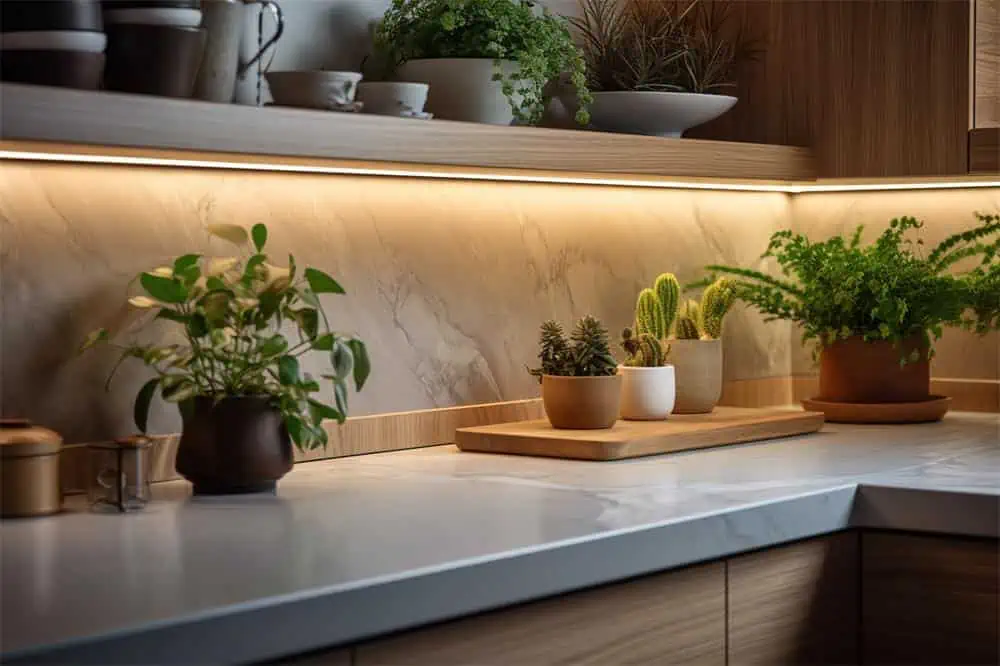
Tips For Purchasing Kitchen Lights
- Know Your Kitchen Requirements: In terms of lighting, first, you need to understand what your kitchen needs. Identify the key areas that require illumination, such as task areas, dining spaces, or accent lighting. Consider your kitchen’s style and layout as well. After that, you can use certain types of lights for specific areas.
- Consider Color Temperature: Another main factor to consider before purchasing kitchen lights is color temperature. There are different color temperatures available. You have to choose the one that aligns with the kitchen design and your ambiance goals. For a cozy and welcoming environment, you can go with warmer temperatures, but for a modern look, choose a cooler one. How to Choose LED Strip Color Temperature?
- Go For High CRI Rating: The Color Rendering Index (CRI) scores a maximum of 100. A higher CRI number (90+) ensures that the lighting accurately and adequately reflects colors in the kitchen. Therefore, go with a high CRI rating for making food and decor appear as they should.
- Appropriate Lumen: Lumen measures the brightness of the lights, so consider the correct lumen output for each area in your kitchen. For general kitchen lighting, aim for around 5,000 to 10,000 lumens. However, task areas over the stove or countertop can need more lumens, about 300-400 per square foot. This way, you can get a well-illuminated space for cooking.
- IP Ratings: Last but not least, the Ingress Protection (IP) rating is also significant for kitchen lighting, especially for outdoor or near sink areas. This rating indicates the fixture’s resistance to dust and moisture. Such as for indoor use, you can select an IP20 that is usually suitable. But for locations exposed to moisture or water splashes, e.g., the kitchen sink area, you need to consider a high IP rating. For details, read IP Rating: The Definitive Guide.
Top 6 Kitchen Lighting Ideas
Here, I have mentioned the most common top 6 kitchen lighting ideas to help you. By following these, you can illuminate your next kitchen lighting project.
1. Play With Pendants
Pendant light fixtures are also known as drop lights, a versatile option for kitchens. These lights come in multiple designs, sizes, and shapes, which make them ideal for any kitchen decor. For instance, if you want to focus lighting on the kitchen’s dining area or island, you can set some pendants to create intimate and cozy surroundings. You can install these fixtures by hanging them from the ceiling with a metal rod, cord, and chain. Like the picture below, you can set similar pendants for more vibrant illumination and style.
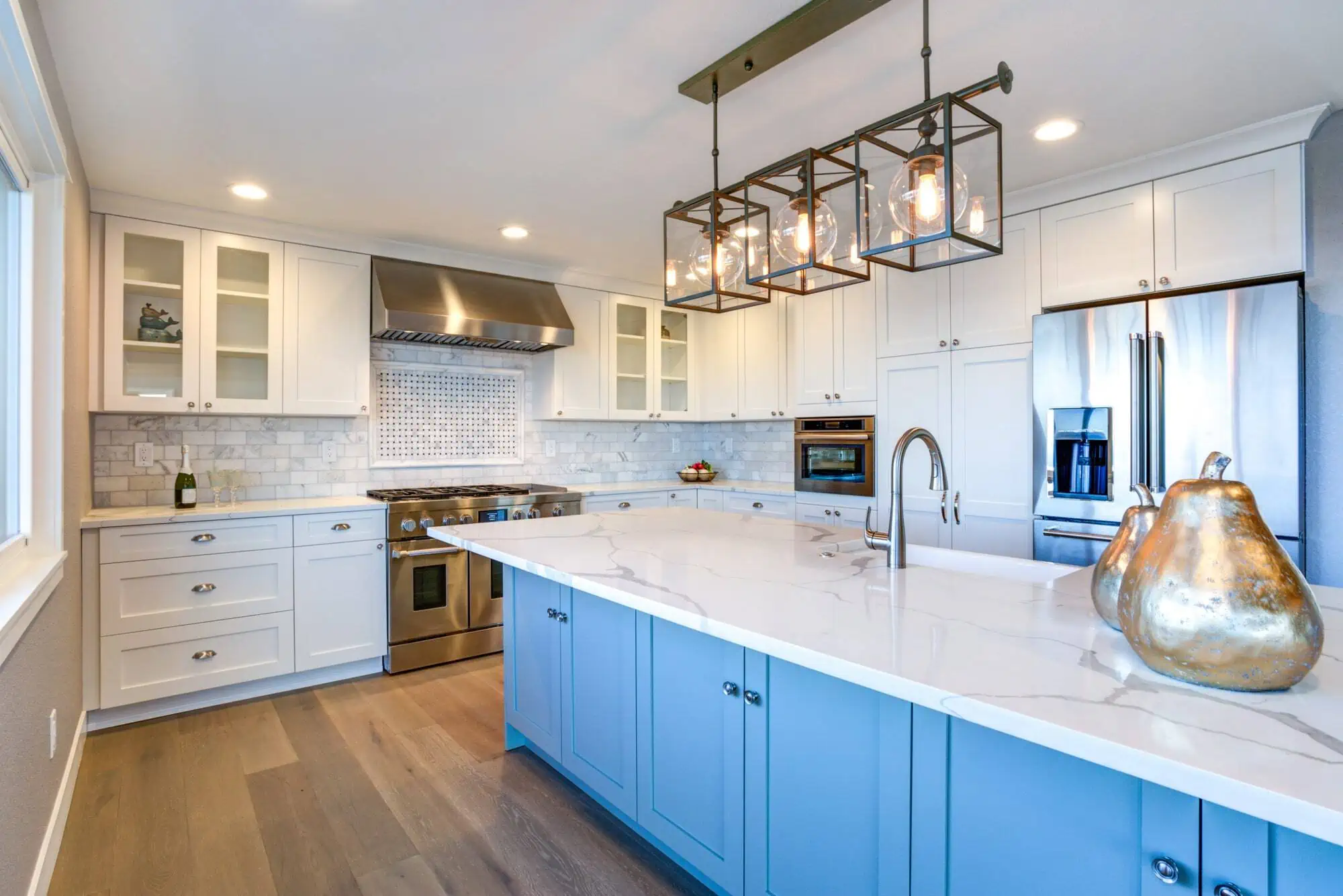
2. Using Under Cabinet Lighting
Under cabinet lighting is the most useful task lighting for the kitchen area, as they are used to make direct illumination in the work zone. For this, you can install LED strips, puck lights, and slim fixtures and set these below the wall cabinets. These lights are an excellent choice for brightening up dull and dark corners. Also, with these, you can remove the cabinet shadows from the countertop. Therefore, under cabinets will help you to work on cutting, chopping, and cooking more quickly and efficiently without facing any trouble. They also make your kitchen space dreamy, feel larger, and give a proper ambiance, no matter if the main lights are off or on.
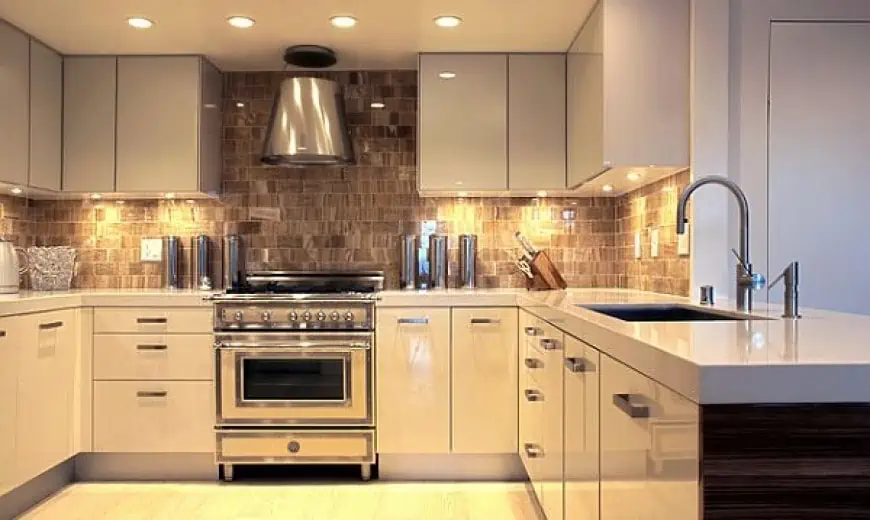
3. Consider Dimmable Lights
It’s essential to have bright lighting in the kitchen for practical reasons, such as making your kitchen a cozy evening retreat. So, you can consider investing in dimmable lighting. This allows you to change the ambiance instantly. There are many simple lighting techniques to create a warm and inviting atmosphere. For instance, from overhead spotlights on worktops and above islands to features like candles, rattan lamps, and under-cabinet lighting. The key is strategically positioning them to create pockets of light and shadow, drawing attention to various aspects. Also, dimmable lighting is valuable in smaller kitchens with limited space for additional lighting sources. For example, table or floor lamps or closed-faced cupboards restrict natural light. So, you can make the flexibility to shift from bright, functional cooking illumination to a more relaxed setting for dining or casual kitchen activities with dimmable options.
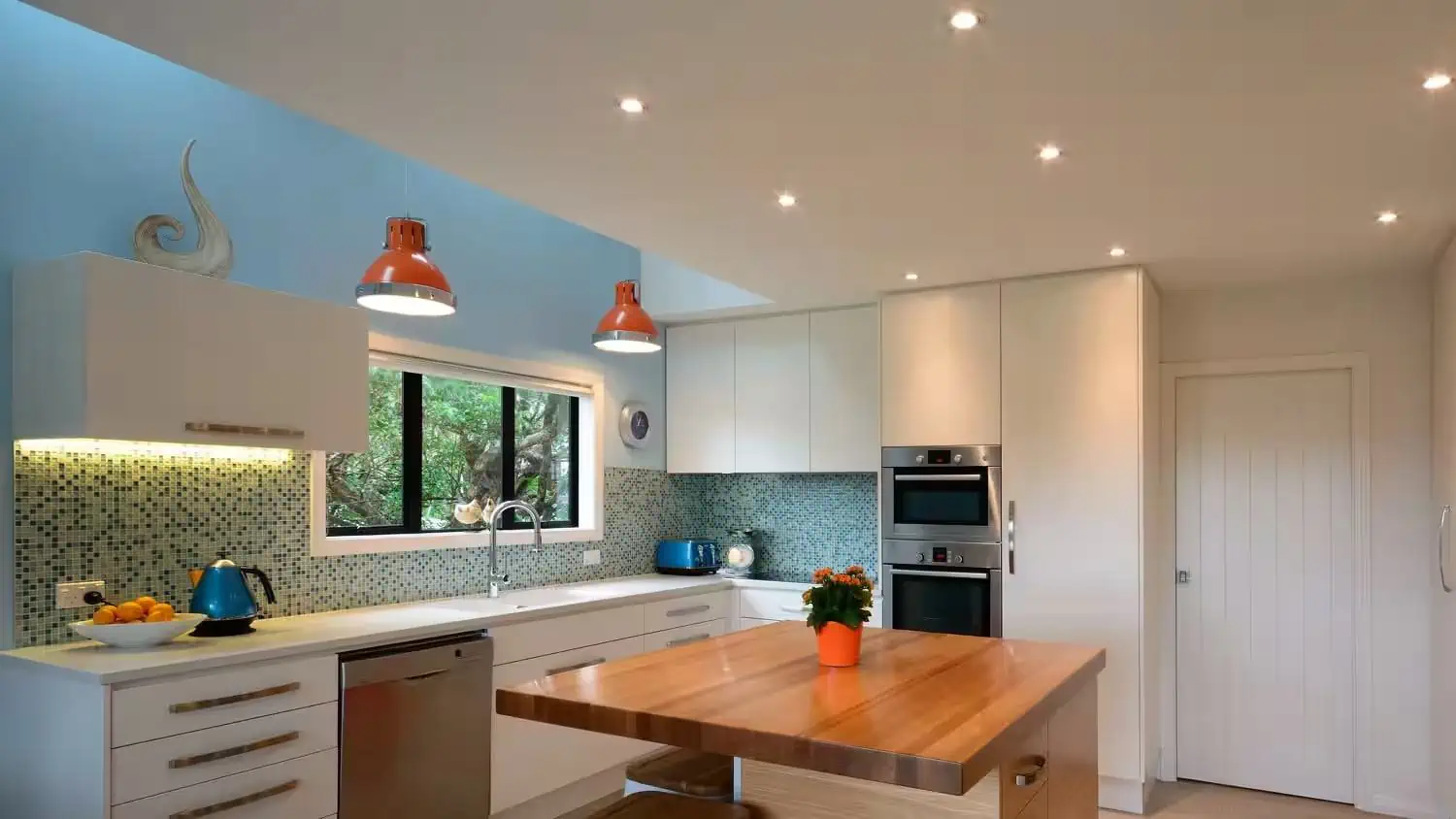
4. Make A Statement Of Dinnerware With Cabinet Lighting
When you have exquisite crystalware or dish collections, why keep them in darkness? This lighting idea adds a touch of elegance and provides a functional and artistic design. By incorporating cabinet lighting, you can showcase your collection of fine dinnerware, glassware, or decorative items. And it will turn them into eye-catching focal points within your kitchen. Besides, you need to place these lights strategically within glass-front cabinets, shelves, or display units. And the warm, subtle glow of the lighting emphasizes the colors and textures of your dinnerware. This illumination creates a visually stunning effect. Also, it adds a sense of depth and dimension to your kitchen space. Furthermore, the soft illumination provided by cabinet lighting is particularly helpful during evening gatherings. Also, this offers an additional light source when hosting a romantic dinner or entertaining friends.
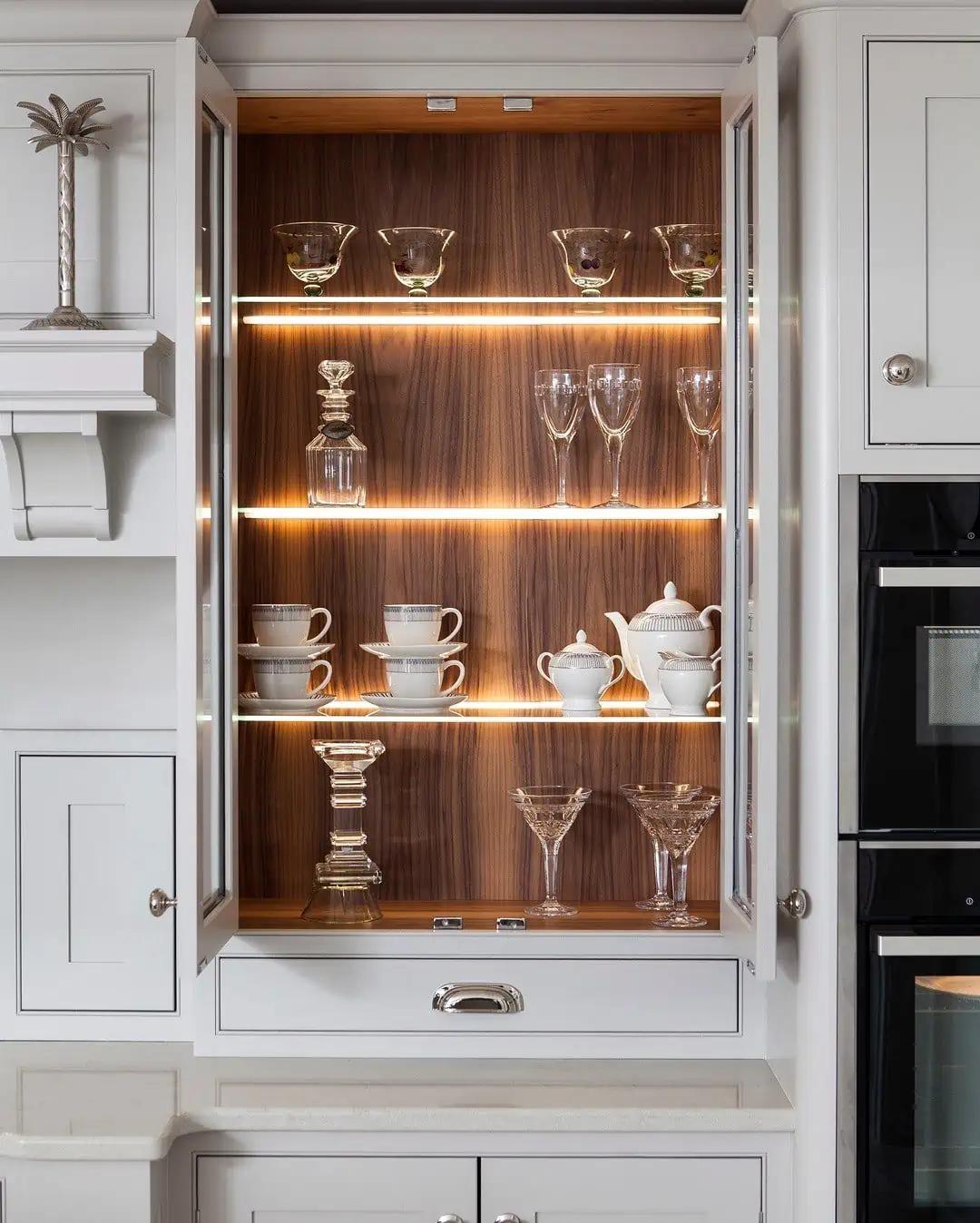
5. Zone Your Space With Lighting
You need to have features of multifunctionality in the layout and lighting to make many zones in the kitchen. This way, you can use spaces that can be used for multiple activities individually and simultaneously. Besides, the most efficient lighting strategy involves designing a system that provides strong, focused lighting over the countertops during food preparation and soft, gentle lighting for the guests. While the distance between these two distinct light sources may be minimal, it significantly enhances the experience for your guests and the chef or host. Such well-planned lighting and seating arrangements promote a relaxed and enjoyable atmosphere in the kitchen. Also, it enhances the informal dining experience.
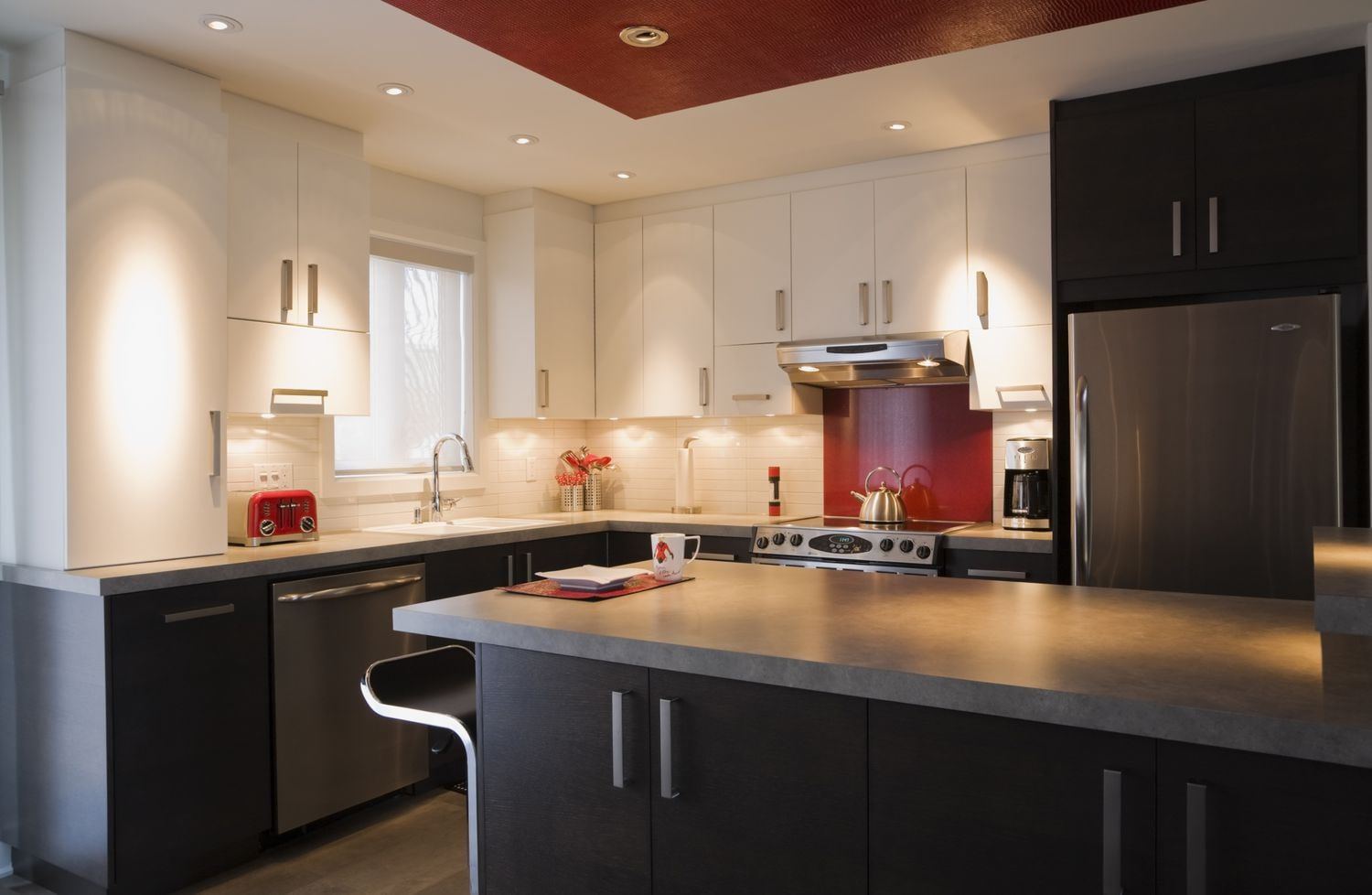
6. Think About ‘Unconventional’ Kitchen Lighting
For larger kitchens, you have the creative freedom to explore unconventional lighting solutions, like floor and tabletop lamps. This illuminates your kitchen and becomes an integral element of your kitchen layout. While kitchens primarily serve helpful purposes, it’s essential to consider lightning’s role even when it’s not purely functional. In addition, islands often become social hubs, so low-level or pendant lighting in these areas can enhance the ambiance. Also, you can integrate living room lighting options into the kitchen, such as a floor lamp in a corner or a table lamp on a countertop to add warmth. For instance, versatile lighting solutions, including pendants, wall lights, floor lamps, and ceiling fittings, seamlessly blend into larger or open-plan kitchen spaces.
Hence, incorporating lamps provides the flexibility to create soft accent lighting or task-oriented illumination, depending on your chosen bulbs. Also, color-changing bulbs enable you to switch from bright white lighting for kitchen tasks to a cozy, relaxed atmosphere when desired.
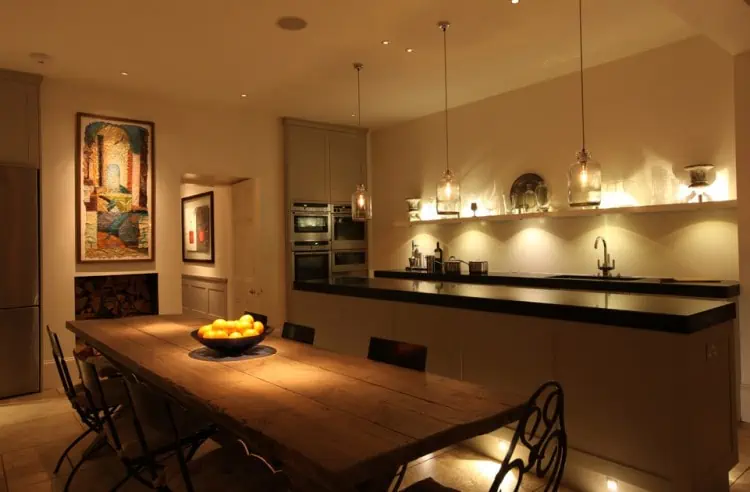
FAQs
To ensure functionality and safety, you need a task and ambient light. While based on your kitchen setup, you can also install accent lighting to emphasize specific pieces in the space. So, make sure to choose a light that can go with the wet and grimy environment of the kitchen.
When choosing a kitchen light fixture, you must consider the lighting function you want. Then, match your home decor with the light fixture style for the best result. Also, you need to determine the pricing as there are so many ranges of prices available. Therefore, choose one light fixture that aligns with the budget.
Select a light fixture that provides the right amount of illumination for your kitchen areas. Also, that harmonizes with your design preferences. The best way to do this is to explore various shops to discover the ideal kitchen chandelier for your place. But the time and effort will be rewarding when you find the most beautiful kitchen chandelier.
The best brightness for kitchen lights is recommended as 4,000-8,000 lumens. With this brightness level, you will get sufficient illumination in your kitchen to do chopping, choking, and other food preparation activities with ease.
Choosing between warm or neutral kitchen lighting depends on your design and ambiance goals. Warm lighting (around 2700k-3000K) creates a cozy, welcoming atmosphere. In comparison, neutral lighting (about 4000-5000K) offers a clean, modern look. Hence, consider your kitchen’s style and desired illumination to make the right choice.
Darker colors and shades need to be avoided for the kitchen, such as red, green, black, purple, blue, etc. Because these colors make the area look small and absorb the brightness. As a result, they give the kitchen a gloomy ambiance.
The color can make an illusion to change your kitchen. Cooler light colors can help to make the space feel larger. Conversely, darker and warmer colors can make your areas small. Likewise, what textures you select will switch the feel and look of your kitchen.
Both 4000K and 5000K lighting suit a kitchen, but the choice depends on personal preference and needs. For example, 4000K offers a balanced, cool-white light, while 5000K provides a crisper, daylight-like brightness. So, consider your kitchen’s style and ambiance; 4000K is often preferred for detail-oriented work. But 5000K lends a modern, energetic vibe and is often seen in commercial areas.
The settings of pendant lights depend on the size of the fixtures. You need to keep the gap between each pendant equal to or greater than the width or diameter of the fixture. So, to ensure good lighting, aim to position your pendant lights with at least a 2-foot separation. But, if you have a single long pendant, it should be centered over the island and cover no more than two-thirds of the island’s width.
You can place recessed lights on the edges of the countertop. This way, the lights will effectively brighten the work areas and the sink, preventing shadows from working at the counters. For optimal placement, position the recessed lights approximately 12 inches apart and maintain a distance of 12 to 18 inches from any cabinets. This arrangement ensures proper illumination of both the counter spaces and working areas.
Bottom Line
Besides kitchen interior decoration, light color also plays a significant role in its overall outlook. For this, you must first decide what light tone you want for the kitchen- warm or cool. To decide this, consider the size of your kitchen. Warm lights are unsuitable for all kitchens as they can make small kitchens look smaller.
So, it is better to go for cool lights if you have a small kitchen. Apart from this, consider the style of your kitchen in choosing the ideal fixture. Tunable LED strip lights are an excellent choice here; you can adjust these lights from warm to cool temperatures and get the desired light color you want for your kitchen based on your working needs. Installing these strips under your kitchen cabinets or shelves allows you to use them for accent lighting.
However, for the best quality LED strip lights for your kitchen, LEDYi is your ultimate solution. We have all the light colors you desire for your kitchen. Whether your house kitchen or a commercial one, LEDYi is here to provide premium lighting. We further have customized options with ODM and OEM facilities. So why wait? Place an order ASAP.
